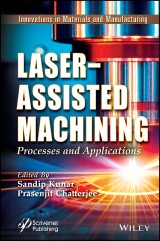Details
Laser-Assisted Machining
Processes and ApplicationsInnovations in Materials and Manufacturing 1. Aufl.
|
214,99 € |
|
| Verlag: | Wiley |
| Format: | |
| Veröffentl.: | 26.04.2024 |
| ISBN/EAN: | 9781394214648 |
| Sprache: | englisch |
| Anzahl Seiten: | 496 |
DRM-geschütztes eBook, Sie benötigen z.B. Adobe Digital Editions und eine Adobe ID zum Lesen.
Beschreibungen
<b>LASER-ASSISTED MACHINING</b> <p> <b>This unique book develops exhaustive engineering perceptions of different laser-assisted techniques, reviews the engineering context of different laser fabrication techniques, and describes the application of laser-assisted fabrication techniques.</b> <p>Lasers are essential in the area of material processing because they can produce coherent beams with little divergence. The fabrication process known as surface cladding includes joining (soldering, welding), material removal (laser-aided drilling, cutting, etc.), deformation (extrusion, bending), and material addition. Some remarkable advantages of laser-assisted material development include faster processing rates and preservation of essential alloying components. However, the lack of widespread understanding of various material phenomena and how laser parameters affect them prevents the technology from being widely accepted on an industrial scale. <p>Among the subjects <i>Laser-Assisted Machining </i>covers include high-powered lasers in material processing applications, laser-based joining of metallic and non-metallic materials, direct laser cladding, laser surface processing, laser micro and nano processing, emerging laser materials processing techniques, solid-state lasers, laser cutting, drilling and piercing, laser welding, laser bending or forming, laser cleaning, laser automation and in-process sensing, femtosecond laser micromachining, laser-assisted micro-milling/grinding, laser-assisted jet electrochemical micro-machining, laser-assisted water jet micro-machining, hybrid laser-electrochemical micromachining process, quill and nonreciprocal ultrafast laser writing, laser surface engineering, ultrashort pulsed laser surface texturing, laser interference patterning systems, laser interference lithography, laser-guided discharge texturing. <p><b>Audience</b> <p>The book will be used by researchers in the fields of manufacturing technology and materials science as well as engineers and high-level technicians for a better understanding of various innovative and novel techniques to cope with the need of micromachining, as well as microfabrication industries for successful implementation of microproduct manufacturing.
<p><b>Sandip Kunar, PhD, </b> is an assistant professor in the Department of Mechanical Engineering, Aditya Engineering College, A.P., India. He has published more than 50 research papers in various reputed international journals, national and international conference proceedings, 16 book chapters, and 9 books as well as two patents. His research interests include non-conventional machining processes, micromachining processes, advanced manufacturing technology, and industrial engineering. <p><b>Prasenjit Chatterjee, PhD, </b> is a Professor of Mechanical Engineering and Dean (Research and Consultancy) at MCKV Institute of Engineering, West Bengal, India. He has more than 5550 citations, h index of 39, and 120+ research papers in various international journals and peer-reviewed conferences. He has authored and edited more than 33 books on intelligent decision-making, fuzzy computing, supply chain management, optimization techniques, risk management and sustainability modeling. He has received numerous awards including Best Track Paper Award, Outstanding Reviewer Award, Best Paper Award, Outstanding Researcher Award and University Gold Medal. He is the Editor-in-Chief of <i>Journal of Decision Analytics and Intelligent Computing</i>. He is one of the developers of two multiple-criteria decision-making methods called Measurement of Alternatives and Ranking according to COmpromise Solution (MARCOS) and Ranking of Alternatives through Functional mapping of criterion sub-intervals into a Single Interval (RAFSI).
<p> <b>This unique book develops exhaustive engineering perceptions of different laser-assisted techniques, reviews the engineering context of different laser fabrication techniques, and describes the application of laser-assisted fabrication techniques.</b> <p>Lasers are essential in the area of material processing because they can produce coherent beams with little divergence. The fabrication process known as surface cladding includes joining (soldering, welding), material removal (laser-aided drilling, cutting, etc.), deformation (extrusion, bending), and material addition. Some remarkable advantages of laser-assisted material development include faster processing rates and preservation of essential alloying components. However, the lack of widespread understanding of various material phenomena and how laser parameters affect them prevents the technology from being widely accepted on an industrial scale. <p>Among the subjects <i>Laser-Assisted Machining </i>covers include high-powered lasers in material processing applications, laser-based joining of metallic and non-metallic materials, direct laser cladding, laser surface processing, laser micro and nano processing, emerging laser materials processing techniques, solid-state lasers, laser cutting, drilling and piercing, laser welding, laser bending or forming, laser cleaning, laser automation and in-process sensing, femtosecond laser micromachining, laser-assisted micro-milling/grinding, laser-assisted jet electrochemical micro-machining, laser-assisted water jet micro-machining, hybrid laser-electrochemical micromachining process, quill and nonreciprocal ultrafast laser writing, laser surface engineering, ultrashort pulsed laser surface texturing, laser interference patterning systems, laser interference lithography, laser-guided discharge texturing. <p><b>Audience</b> <p>The book will be used by researchers in the fields of manufacturing technology and materials science as well as engineers and high-level technicians for a better understanding of various innovative and novel techniques to cope with the need of micromachining, as well as microfabrication industries for successful implementation of microproduct manufacturing.
Diese Produkte könnten Sie auch interessieren:

Chemistry for the Protection of the Environment 4

von: Robert Mournighan, Marzenna R. Dudzinska, John Barich, Marjorie A. Gonzalez, Robin K. Black

213,99 €
















